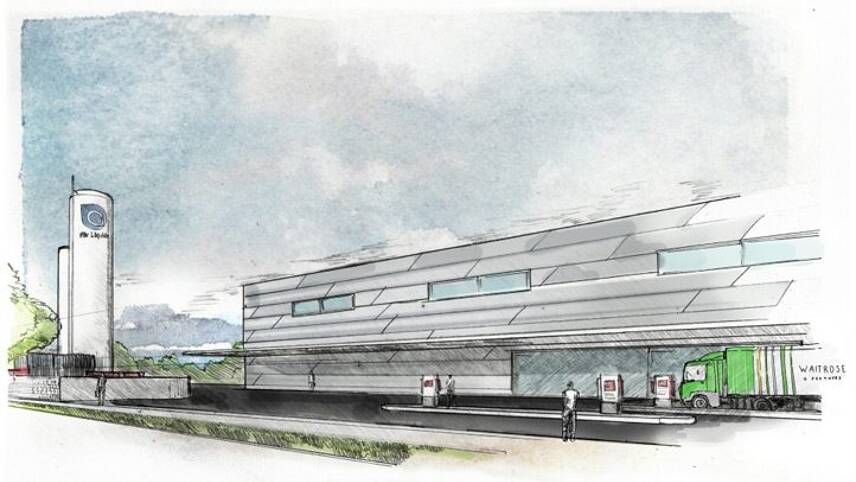Register for free and continue reading
Join our growing army of changemakers and get unlimited access to our premium content

Pictured: An artist's impression of the proposed facility
The new facility, which will produce fuel from waste, will come online in December 2020 and will serve 120 of Waitrose’s heavy goods vehicles (HGVs). By this time, John Lewis Partnership estimates that 228 of its HGVs will have been replaced with biomethane alternatives.
According to Air Liquide, the multinational gas firm which has partnered with John Lewis Partnership to develop the new facility, bio-methane trucks generate just 20% of the carbon dioxide associated with traditional diesel models, on a life-cycle basis. The new refuelling facility alone will mitigate the emission of 70,000 tonnes of CO2 equivalent over the next seven years, it claims.
John Lewis Partnership is already sourcing biomethane from third-party filling stations in Lancashire, Leyland and Northampton, under ongoing partnerships with Air Liquide and CNG Fuels. But this is the first time that the firm will be able to refuel its biomethane trucks on-site, and is also believed to be a first for the UK’s retail sector.
Aside from HGVs, John Lewis Partnership has made an additional commitment to remove fossil-fuel-powered vehicles from its entire business fleet by 2030. The retailer estimates that it will have 1,750 vans, 750 refrigerated trailers and 1,300 cars in its fleet by this time, meaning the achievement of the ambition will prove no mean feat. Investments will be made into pure-electric cars and vans, and into biomethane and hydrotreated vegetable oil (HVO) biodiesel where electric solutions are not commercially or technologically viable.
“The evidence of climate change is all around us, so it’s important we act now using available technology rather than wait for unproven solutions to appear,” John Lewis Partnership’s general manager of central transport, Justin Laney, said.
Laney added that removing all fossil-fuel-powered vehicles from the business fleet by 2030 will mitigate the emission of more than 500,000 tonnes of carbon dioxide equivalent.
John Lewis Partnership is notably working towards a 2050 net-zero target. The firm’s director of corporate responsibility Benet Northcote last year provided edie with an in-depth look at plans to meeting this ambition, and the rationale behind its development.
Need a Lyft?
In related news, ride-hailing giant Lyft has this week joined The Climate Group’s EV100 initiative and set a 2030 target for electrifying 100% of its global fleet.
Lyft predicts that it will have more than two million vehicles in operation by this time, with the majority based in Canada and the US.
It is developing a package of incentives and resources to help its drivers make the transition to fully-electric – a transition it believes will now have more public support, given that most are keen to preserve the improvements to air quality recorded during Covid-19 lockdowns.
Both The Climate Group and Lyft believe that the commitment will serve to motivate other businesses in the transport sector to accelerate their decarbonisation journeys.
“Success breeds success, and if we do this right, it creates a path for others,” Lyft co-founder John Zimmer said. “By adopting our 100% EVs by 2030 commitment and joining EV100, we hope to inspire other rideshare and delivery companies, automakers and rental car companies to make this shift and provide the catalyst for transforming transportation as a whole.”
Lyft’s largest competitor, Uber, has not set a time-bound, numerical target for EV adoption in the US, or, indeed, for any of its other 63 national markets except the UK. In the UK, all Uber journeys will be made by pure-electric or hybrid-electric vehicles by 2025.
Sarah George


Please login or Register to leave a comment.